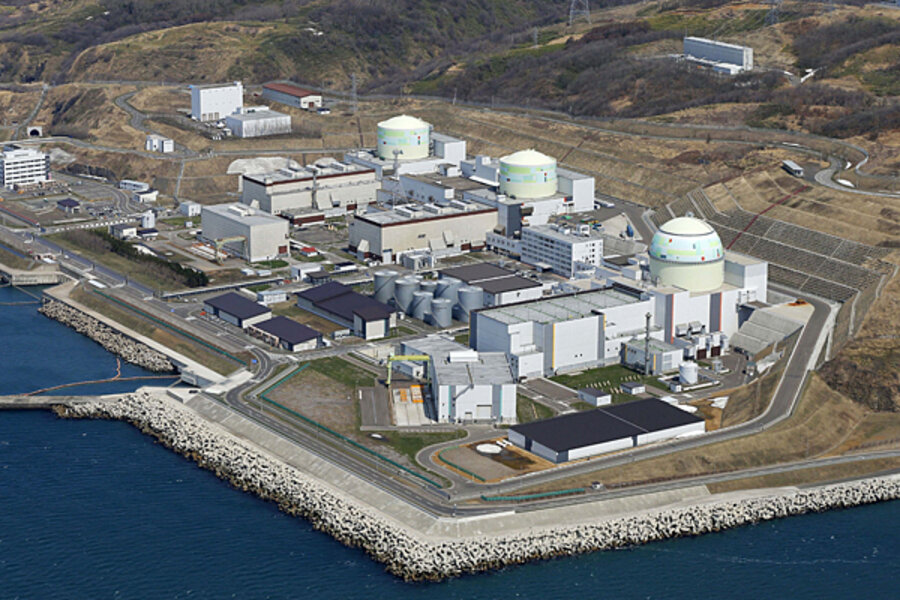Japan shuts down last nuclear reactor for tests. End of nuclear power?
Loading...
| Tokyo
This weekend's nuclear shutdown in Japan is being greeted with a mixture of anxiety and optimism, just over a year since the Fukushima Daiichi nuclear power plant accident signaled the beginning of the end of the country's dependence on atomic energy.
By May 6, the last of Japan's 50 working reactors – another four were crippled in the disaster – will be offline when the Hokkaido Electric Power Company closes the No. 3 unit at its Tomari plant in the far north, in the industry's first enforced closure in Japan since 1965.
Debate is now swirling around the prospects for the economy and environment post-Fukushima, as Japan braces itself for a long, hot summer and the possibility of power cuts that could prove the most severe test of public resolve yet.
Before the 11 March disaster, Japan relied on nuclear power for about 30 percent of its electricity, and planned to increase its share to more than 50 percent by 2030.
To make up the shortfall in power production it has dramatically increased its dependence on liquefied natural gas (LNG), coal and oil for use in thermal power stations. LNG imports alone rose 52 percent in value to 5.4 trillion yen ($67 billion) in the year through March.
That may have kept the lights on in the world's third-biggest economy, but it has also rung alarm bells among manufacturers and cast doubt on Japan's ability to meet greenhouse-gas emissions targets agreed on in Copenhagen in 2009.
In a preliminary report released this week, the government's national policy unit projected a 5 percent power shortage for Tokyo, while the Kansai Electric Power Company predicted a 16 percent power shortfall in western Japan, which includes the major industrial city of Osaka.
"I have to say we are facing the risk of a very severe electricity shortage," said the economy, trade and industry minister, Yukio Edano, adding that the extra cost of importing fuel for use in thermal power stations could be passed on to individual consumers though higher electricity bills.
Public mood
Despite the risks, Mr. Edano and other government ministers have failed to persuade local authorities to restart two reactors at Oi nuclear power plant in Fukui Prefecture, situated in western Japan – the first to pass mandatory stress tests to gauge their ability to withstand disasters such as the tsunami that sent three of Fukushima Daiichi's six reactors into meltdown.
Prime Minister Yoshihiko Noda does not require local approval to order a restart, but the public mood is such that it will take a brave – or possibly reckless – politician to override residents.
In a recent national poll by Kyodo News, almost 60 percent of Japanese citizens were opposed to restarting the Oi reactors, while 26.7 percent were in favor.
Significantly, the Mainichi Shimbun recently became the first major newspaper to come out in favor of ditching nuclear power. "The illusion of nuclear power safety has been torn out by the root," it said in an editorial. "The Fukushima nuclear disaster that followed the great waves of 11 March last year made sure of that."
Opposition from leaders representing areas served by the Oi plant have also made an immediate restart unlikely. "The first evaluation of the stress test is absolutely not sufficient grounds for restarting the Oi reactors," Osaka Mayor Toru Hashimoto told reporters. "I'm totally against it. We are not even sure yet if there will be a power shortage this summer, or by how much."
Resistance to abandoning nuclear energy
But last month, Yoshito Sengoku, the acting president of the governing Democratic Party of Japan, likened the abandonment of nuclear energy to "mass suicide."
Along with grim forecasts from Japan's biggest business lobby, Keidanren, that power rationing and higher fuel bills will hit production and earnings, come warnings that the nuclear shutdown will derail the country's attempts to reduce its carbon footprint.
The environment ministry projects that, without nuclear power, Japan will produce about 15 percent more greenhouse-gas emissions this fiscal year than it did in the baseline year of 1990.
But a ministry panel believes that Japan can still reduce its greenhouse-gas emissions by 25 percent by 2030 from 1990 levels without nuclear, provided it makes energy savings and speeds up the adoption of renewables, which currently account for just 10 percent of the energy mix.
"A nuclear-free Japan is a safer Japan," says Junichi Sato, executive director of Greenpeace Japan. "To ensure a safe, secure and prosperous future, Japan must remain nuclear free by ditching atomic energy in favor of renewable energy."
If Mr. Sato is right and Japan manages to brave the summer heat without power blackouts, the pressure to make the temporary nuclear shutdown permanent could be almost impossible to resist.





